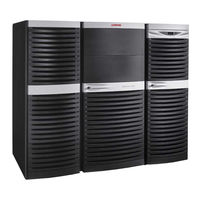Compaq AlphaServer GS80 Manuals
Manuals and User Guides for Compaq AlphaServer GS80. We have 5 Compaq AlphaServer GS80 manuals available for free PDF download: Installation And User Manual, User Manual, Site Preparation Manual
Compaq AlphaServer GS80 Installation And User Manual (290 pages)
System Management Console
Table of Contents
-
Overview15
-
Preface
15 -
-
-
-
SMC Web Page104
-
Security Warning112
-
TDI Certificate114
-
Adding a Console118
-
Adding an Event126
-
Add Event Screen126
-
Adding a Scan134
-
Add Scan Screen134
-
Expunging Events138
-
Managing Users140
-
Adding a User142
-
Add User Screen142
-
User_Name Screen143
-
Adding a Profile148
-
Log File Screen154
-
-
Starting CAPM166
-
SMC Web Page166
-
Overview of CAPM168
-
Login Box168
-
Partition Maps170
-
-
-
Browser Window222
-
Ports Dialog Box228
-
-
B–1 COM1 Port244
-
-
Dress the Cable257
-
-
Advertisement
Compaq AlphaServer GS80 User Manual (234 pages)
System Management Console
Brand: Compaq
|
Category: Music Mixer
|
Size: 3.09 MB
Table of Contents
-
Preface
13 -
-
SMC Desktop22
-
SMC Web Page24
-
Keep in Mind28
-
-
SMC Web Page32
-
-
Overview44
-
SMC Web Page46
-
Telnet Ports64
-
Adding a Scan100
-
Add Scan Screen100
-
Expunging Events104
-
Managing Users106
-
Adding a User108
-
Add User Screen108
-
Services Box114
-
Run Box114
-
Adding a Profile116
-
Log File Screen122
-
-
-
Starting CAPM130
-
Overview of CAPM134
-
Login Box134
-
Partition Maps136
-
CAPM Log File168
-
-
-
SMC Web Page188
-
Browser Window190
-
Ports Dialog Box196
-
Color Dialog Box208
-
Consoleworks
212 -
Compaq AlphaServer GS80 User Manual (184 pages)
AlphaServer GS80; AlphaServer 160; AlphaServer 320
Table of Contents
-
Preface
11 -
-
Backplane26
-
CPU Module28
-
Power System40
-
AC Input Box42
-
Pci I/O44
-
-
GS160 System50
-
GS320 System52
-
System Box58
-
PCI Boxes66
-
-
Bootdef_Dev94
-
Boot_File94
-
Boot_Osflags94
-
RIS Boot102
-
Booting Openvms106
-
Infoserver Boot108
-
-
SRM Console113
-
Show Boot119
-
Show Config119
-
Show Device119
-
Show Memory130
-
-
-
Bypass Modes148
-
Entering the SCM152
-
SCM Commands154
Advertisement
Compaq AlphaServer GS80 User Manual (181 pages)
Table of Contents
-
Preface
9 -
-
System Box18
-
Backplane24
-
CPU Module26
-
Power System38
-
AC Input Box40
-
Pci I/O42
-
-
-
GS160 System48
-
GS320 System50
-
System Box56
-
PCI Boxes64
-
-
-
-
Bootdef_Dev92
-
Boot_File93
-
Boot_Osflags94
-
RIS Boot100
-
Booting Openvms104
-
Infoserver Boot106
-
-
SRM Console111
-
-
-
Bypass Modes146
-
Entering the SCM150
-
SCM Commands152
Advertisement




